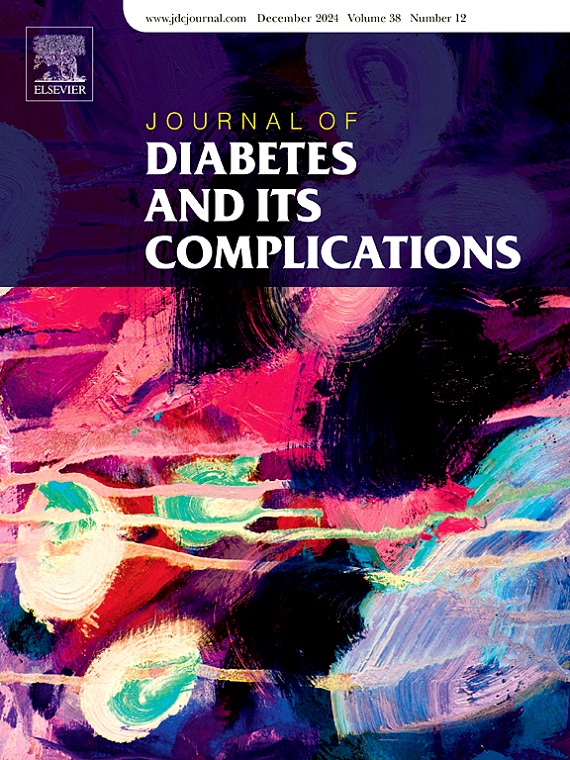小密度低密度脂蛋白-胆固醇升高是2型糖尿病患者下肢动脉疾病的危险因素
IF 3.1
3区 医学
Q3 ENDOCRINOLOGY & METABOLISM
引用次数: 0
摘要
目的:小密度低密度脂蛋白-胆固醇(sdLDL-C)是一种新兴的致动脉粥样硬化脂质标志物,但其与2型糖尿病(T2DM)患者下肢动脉疾病(LEAD)的关系仍未得到充分研究。本研究旨在评估sdLDL-C是否能独立预测T2DM患者的LEAD风险。方法采用横断面研究方法,选取健康对照者47例,T2DM患者66例,T2DM合并LEAD患者120例。比较生化指标,并采用受试者工作特征(ROC)曲线评估预测价值。在调整常规危险因素后,多变量logistic回归分析了sdLDL-C与LEAD之间的关系。结果T2DM患者ldl - c水平显著高于健康对照组(1.06 [0.88-1.25]vs. 0.77 [0.43-1.04] mmol/L, P <;而T2DM和LEAD合并的患者更高(1.33 [1.17-1.56]mmol/L)。sdLDL-C水平与铅的严重程度相关,与空腹血糖、空腹c肽、血红蛋白A1c、总胆固醇、甘油三酯、LDL-C、载脂蛋白B和体重指数呈正相关。ROC分析显示曲线下面积为0.765 (95% CI: 0.692-0.838, P <;0.0001),表明sdLDL-C对T2DM患者的LEAD具有良好的预测价值。多变量logistic回归发现,sdLDL-C (OR = 7.881, 95%CI: 1.368-45.394, P = 0.021)、空腹c肽、糖化血红蛋白、载脂蛋白B、糖尿病病程和久坐生活方式是T2DM患者铅的重要危险因素。结论sdLDL-C升高与T2DM患者的LEAD独立相关,在危险分层上优于常规LDL-C。sdLDL-C可作为这一高危人群早期检测铅的有价值的生物标志物。本文章由计算机程序翻译,如有差异,请以英文原文为准。
Elevated small dense low-density lipoprotein-cholesterol as a risk factor for lower extremity arterial disease in patients with type 2 diabetes mellitus
Aims
Small dense low-density lipoprotein-cholesterol (sdLDL-C) is an emerging atherogenic lipid marker, but its association with lower extremity arterial disease (LEAD) in type 2 diabetes mellitus (T2DM) remains underexplored. This study aimed to evaluate whether sdLDL-C independently predicts LEAD risk in T2DM patients.
Methods
A cross-sectional study was conducted with 47 healthy controls, 66 T2DM patients, and 120 patients with both T2DM and LEAD. Biochemical markers were compared, and predictive value was assessed using a receiver operating characteristic (ROC) curve. Multivariable logistic regression analyzed the association between sdLDL-C and LEAD after adjusting for conventional risk factors.
Results
sdLDL-C levels were significantly higher in T2DM patients compared to healthy controls (1.06 [0.88–1.25] vs. 0.77 [0.43–1.04] mmol/L, P < 0.001), and even higher in those with both T2DM and LEAD (1.33 [1.17–1.56] mmol/L). sdLDL-C levels were associated with the severity of LEAD and positively correlated with fasting blood glucose, fasting C-peptide, hemoglobin A1c, total cholesterol, triglycerides, LDL-C, apolipoprotein B, and body mass index. ROC analysis yielded an area under the curve of 0.765 (95 % CI: 0.692–0.838, P < 0.0001), indicating good predictive value of sdLDL-C for LEAD in T2DM. Multivariable logistic regression identified sdLDL-C (OR = 7.881, 95%CI: 1.368–45.394, P = 0.021), fasting C-peptide, hemoglobin A1c, apolipoprotein B, diabetes duration, and sedentary lifestyle as significant risk factors for LEAD in T2DM patients.
Conclusions
Elevated sdLDL-C is independently associated with LEAD in T2DM patients and outperforms conventional LDL-C in risk stratification. sdLDL-C may serve as a valuable biomarker for early detection of LEAD in this high-risk population.
求助全文
通过发布文献求助,成功后即可免费获取论文全文。
去求助
来源期刊

Journal of diabetes and its complications
医学-内分泌学与代谢
CiteScore
5.90
自引率
3.30%
发文量
153
审稿时长
16 days
期刊介绍:
Journal of Diabetes and Its Complications (JDC) is a journal for health care practitioners and researchers, that publishes original research about the pathogenesis, diagnosis and management of diabetes mellitus and its complications. JDC also publishes articles on physiological and molecular aspects of glucose homeostasis.
The primary purpose of JDC is to act as a source of information usable by diabetes practitioners and researchers to increase their knowledge about mechanisms of diabetes and complications development, and promote better management of people with diabetes who are at risk for those complications.
Manuscripts submitted to JDC can report any aspect of basic, translational or clinical research as well as epidemiology. Topics can range broadly from early prediabetes to late-stage complicated diabetes. Topics relevant to basic/translational reports include pancreatic islet dysfunction and insulin resistance, altered adipose tissue function in diabetes, altered neuronal control of glucose homeostasis and mechanisms of drug action. Topics relevant to diabetic complications include diabetic retinopathy, neuropathy and nephropathy; peripheral vascular disease and coronary heart disease; gastrointestinal disorders, renal failure and impotence; and hypertension and hyperlipidemia.
 求助内容:
求助内容: 应助结果提醒方式:
应助结果提醒方式:


